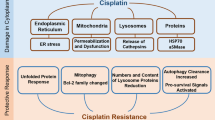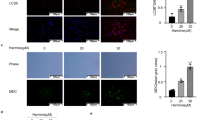Abstract
Objective
PARP inhibitors combined with antiangiogenic drugs have been reported to improve outcomes in BRCA wild-type ovarian cancer patients, the mechanism of the combination is unclear. In this study, we explored the mechanism of apatinib combined with olaparib in the treatment of ovarian cancer.
Methods
In this study, human ovarian cancer cell lines A2780 and OVCAR3 were used as experimental objects, and the expression of ferroptosis-related protein GPX4 after treatment with apatinib and olaparib was detected by Western blot. The SuperPred database was used to predict the target of the combined action of apatinib and olaparib, and the predicted results were verified by Western blot experiment to explore the mechanism of ferroptosis induced by apatinib and olaparib.
Results
Apatinib combined with olaparib-induced ferroptosis in p53 wild-type cells, and p53 mutant cells developed drug resistance. The p53 activator RITA sensitized drug-resistant cells to ferroptosis induced by apatinib combined with olaparib. Apatinib combined with olaparib-induced ferroptosis via a p53-dependent manner in ovarian cancer. Further studies showed that apatinib combined with olaparib-induced ferroptosis by inhibiting the expression of Nrf2 and autophagy, thereby inhibiting the expression of GPX4. The Nrf2 activator RTA408 and the autophagy activator rapamycin rescued the combination drug-induced ferroptosis.
Conclusion
This discovery revealed the specific mechanism of ferroptosis induced by apatinib combined with olaparib in p53 wild-type ovarian cancer cells and provided a theoretical basis for the clinical combined use of apatinib and olaparib in p53 wild-type ovarian cancer patients.





Similar content being viewed by others
Data availability
The datasets of this study are available from the corresponding author on reasonable request.
References
Cao JY, Dixon SJ (2016) Mechanisms of ferroptosis. Cell Mol Life Sci 73(11–12):2195–2209
Chen J, Qin C, Zhou Y, Chen Y, Mao M, Yang J (2022) Metformin may induce ferroptosis by inhibiting autophagy via lncRNA H19 in breast cancer. FEBS Open Bio 12(1):146–153
Deng HF, Yue LX, Wang NN et al (2021) Mitochondrial iron overload-mediated inhibition of Nrf2-HO-1/GPX4 assisted ALI-induced nephrotoxicity. Front Pharmacol 11:624529
Ding J, Cheng XY, Liu S et al (2019) Apatinib exerts anti-tumour effects on ovarian cancer cells. Gynecol Oncol 153(1):165–174
Dixon SJ, Lemberg KM, Lamprecht MR et al (2012) Ferroptosis: an iron-dependent form of nonapoptotic cell death. Cell 149(5):1060–1072
Foo T, George A, Banerjee S (2021) PARP inhibitors in ovarian cancer: an overview of the practice-changing trials. Genes Chromosomes Cancer 60(5):385–397
Frias DP, Gomes RLN, Yoshizaki K et al (2020) Nrf2 positively regulates autophagy antioxidant response in human bronchial epithelial cells exposed to diesel exhaust particles. Sci Rep 10(1):3704
Hong T, Lei G, Chen X et al (2021) PARP inhibition promotes ferroptosis via repressing SLC7A11 and synergizes with ferroptosis inducers in BRCA-proficient ovarian cancer. Redox Biol 42:101928
Hou W, Xie Y, Song X et al (2016) Autophagy promotes ferroptosis by degradation of ferritin. Autophagy 12(8):1425–1428
Jiang L, Kon N, Li T et al (2015) Ferroptosis as a p53-mediated activity during tumour suppression. Nature 520(7545):57–62
Kang R, Kroemer G, Tang D (2019) The tumor suppressor protein p53 and the ferroptosis network. Free Radic Biol Med 133:162–168
Kocaturk NM, Akkoc Y, Kig C, Bayraktar O, Gozuacik D, Kutlu O (2019) Autophagy as a molecular target for cancer treatment. Eur J Pharm Sci 134:116–137
Lau A, Zheng Y, Tao S et al (2013) Arsenic inhibits autophagic flux, activating the Nrf2-Keap1 pathway in a p62-dependent manner. Mol Cell Biol 33(12):2436–2446
Lee YS, Lee DH, Choudry HA, Bartlett DL, Lee YJ (2018) Ferroptosis-induced endoplasmic reticulum stress: cross-talk between ferroptosis and apoptosis. Mol Cancer Res 16(7):1073–1076
Li L, Qiu C, Hou M et al (2021) Ferroptosis in ovarian cancer: a novel therapeutic strategy. Front Oncol 11:665945
Liang C, Zhang X, Yang M, Dong X (2019) Recent progress in ferroptosis inducers for cancer therapy. Adv Mater 31(51):e1904197
Lin Y, Qin S, Li Z et al (2022) Apatinib vs placebo in patients with locally advanced or metastatic, radioactive iodine-refractory differentiated thyroid cancer: the REALITY randomized clinical trial. JAMA Oncol 8(2):242–250
Liu JF, Barry WT, Birrer M et al (2014) Combination cediranib and olaparib versus olaparib alone for women with recurrent platinum-sensitive ovarian cancer: a randomised phase 2 study. Lancet Oncol 15(11):1207–1214
Liu J, Kuang F, Kroemer G, Klionsky DJ, Kang R, Tang D (2020) Autophagy-dependent ferroptosis: machinery and regulation. Cell Chem Biol 27(4):420–435
Qin S, Li Q, Gu S et al (2021) Apatinib as second-line or later therapy in patients with advanced hepatocellular carcinoma (AHELP): a multicentre, double-blind, randomised, placebo-controlled, phase 3 trial. Lancet Gastroenterol Hepatol 6(7):559–568
Ruan X, Liang JH, Pan Y et al (2021) Apatinib for the treatment of metastatic or locoregionally recurrent nasopharyngeal carcinoma after failure of chemotherapy: a multicenter, single-arm, prospective phase 2 study. Cancer 127(17):3163–3171
Schut AW, Vriends ALM, Sacchetti A et al (2022) In desmoid-type fibromatosis cells sorafenib induces ferroptosis and apoptosis, which are enhanced by autophagy inhibition. Eur J Surg Oncol 48(7):1527–1535
Siegel RL, Miller KD, Fuchs HE, Jemal A (2022) Cancer statistics, 2022. CA Cancer J Clin 72(1):7–33
Song X, Zhu S, Chen P et al (2018) AMPK-Mediated BECN1 Phosphorylation Promotes Ferroptosis by Directly Blocking System Xc- Activity. Curr Biol 28(15):2388-2399.e5
Sun D, Li YC, Zhang XY (2021) Lidocaine promoted ferroptosis by targeting miR-382-5p /SLC7A11 axis in ovarian and breast cancer. Front Pharmacol 12:681223
Sung H, Ferlay J, Siegel RL et al (2021) Global cancer statistics 2020: GLOBOCAN estimates of incidence and mortality worldwide for 36 cancers in 185 countries. CA Cancer J Clin 71(3):209–249
Tarangelo A, Magtanong L, Bieging-Rolett KT et al (2018) p53 suppresses metabolic stress-induced ferroptosis in cancer cells. Cell Rep 22(3):569–575
Tian X, Li S, Ge G (2021) Apatinib promotes ferroptosis in colorectal cancer cells by targeting ELOVL6/ACSL4 signaling. Cancer Manag Res 13:1333–1342
Tung MC, Lin PL, Wang YC et al (2015) Mutant p53 confers chemoresistance in non-small cell lung cancer by upregulating Nrf2. Oncotarget 6(39):41692–41705
Wang Z, Yin P, Sun Y et al (2020) LGR4 maintains HGSOC cell epithelial phenotype and stem-like traits. Gynecol Oncol 159(3):839–849
Wang Q, Bin C, Xue Q et al (2021) GSTZ1 sensitizes hepatocellular carcinoma cells to sorafenib-induced ferroptosis via inhibition of NRF2/GPX4 axis. Cell Death Dis 12(5):426
Wei W (2022) p53-dependent autophagy-mediated DNA repair in the treatment of ovarian cancer with apatinib and olaparib. Dalian Medical University, MA thesis
Wei R, Zhao Y, Wang J et al (2021) Tagitinin C induces ferroptosis through PERK-Nrf2-HO-1 signaling pathway in colorectal cancer cells. Int J Biol Sci 17(11):2703–2717
Wu Z, Geng Y, Lu X et al (2019) Chaperone-mediated autophagy is involved in the execution of ferroptosis. Proc Natl Acad Sci U S A 116(8):2996–3005
Xie Y, Zhu S, Song X et al (2017) The tumor suppressor p53 limits ferroptosis by blocking DPP4 activity. Cell Rep 20(7):1692–1704
Zhang B, Liu L (2021) Autophagy is a double-edged sword in the therapy of colorectal cancer. Oncol Lett 21(5):378
Zhang C, Liu X, Jin S, Chen Y, Guo R (2022) Ferroptosis in cancer therapy: a novel approach to reversing drug resistance. Mol Cancer 21(1):47
Zhao L, Peng Y, He S et al (2021) Apatinib induced ferroptosis by lipid peroxidation in gastric cancer. Gastric Cancer 24(3):642–654
Zhou B, Liu J, Kang R, Klionsky DJ, Kroemer G, Tang D (2020) Ferroptosis is a type of autophagy-dependent cell death. Semin Cancer Biol 66:89–100
Zhu L, Barrett EC, Xu Y, Liu Z, Manoharan A, Chen Y (2013) Regulation of cigarette smoke (CS)-induced autophagy by Nrf2. PLoS ONE 8(4):e55695
Funding
The authors declare that no funds, grants, or other support were received during the preparation of this manuscript.
Author information
Authors and Affiliations
Contributions
CJ and JK designed the study. GY performed the statistical analysis. WY and GY performed the experiments. WY wrote the manuscript. The authors read and approved the final manuscript.
Corresponding authors
Ethics declarations
Conflict of interest
The authors declare that no conflict of interest exists.
Additional information
Publisher's Note
Springer Nature remains neutral with regard to jurisdictional claims in published maps and institutional affiliations.
Rights and permissions
Springer Nature or its licensor (e.g. a society or other partner) holds exclusive rights to this article under a publishing agreement with the author(s) or other rightsholder(s); author self-archiving of the accepted manuscript version of this article is solely governed by the terms of such publishing agreement and applicable law.
About this article
Cite this article
Yue, W., Yupeng, G., Jun, C. et al. Apatinib combined with olaparib induces ferroptosis via a p53-dependent manner in ovarian cancer. J Cancer Res Clin Oncol 149, 8681–8689 (2023). https://doi.org/10.1007/s00432-023-04811-1
Received:
Accepted:
Published:
Issue Date:
DOI: https://doi.org/10.1007/s00432-023-04811-1




